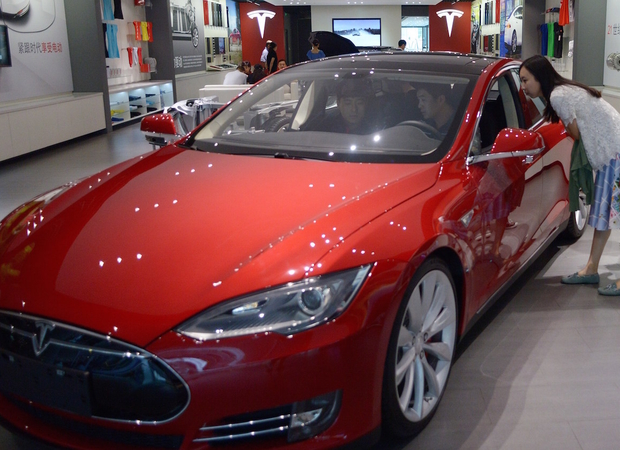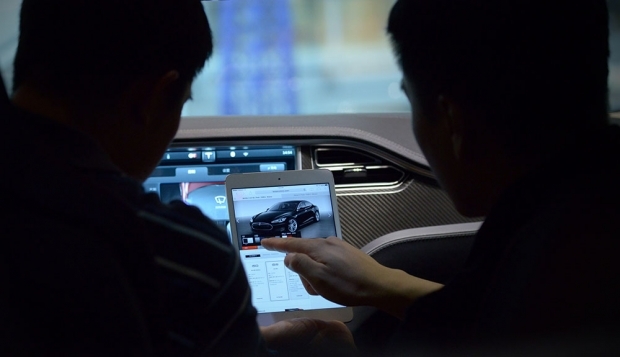Tesla Motors chief executive Elon Musk was mobbed like a pop star last year while introducing Chinese consumers to his U.S. company’s Model S electric car.
Amid the frenzy, the American billionaire-entrepreneur ambitiously predicted China would account for up to 35 percent of his car company’s global sales in 2014.
The prediction proved wrong. In fact, Tesla’s China sales were so disappointing that the company’s China division dismissed two chief executives within a few months of Musk’s visit in April.
Environment
10.23.14
Tesla-Unicom Deal Could Spark China’s Electric Vehicle Market
from chinadialogueBased on vehicle licensing data compiled by the China Automobile Dealers Association, Tesla’s China unit sold only 2,499 electric cars last year, or barely half the number of Model S cars imported into the country. And China sales accounted for only a fraction of the 31,700 Tesla vehicles sold worldwide last year, according to the Nasdaq-listed company’s latest financial report.
But company sales in China strengthened in the first quarter of 2015, with new Tesla owners licensing 1,055 vehicles, according to marketing consultancy JL Warren Capital. Musk’s company is also trying new strategies in hopes of drumming up business under Tom Zhu Xiaotong, Tesla’s current executive in charge of China operations.
Zhu, who once headed Tesla’s charging network development unit in China, has held Tesla’s top position in the country since replacing Veronica Wu Bixuan last August. Wu stepped down after just nine months on the job, apparently a victim of the sluggish sales.
Under Zhu, this year could mark a turnaround for Tesla China. By working to address unique market-access hurdles from battery charging stations to government relations, Zhu’s team hopes to win more consumers by proving Tesla can adapt.
The China team also hopes that at least some of Musk’s predictions about China sales eventually come true.
Challenging Circumstances
Musk may be as popular as a pop star, but his electric car company has a long way to go before it’s a favorite brand in China.
Indeed, Tesla’s China business faces formidable challenges. Zhu recently said the company is wrestling with car-battery charging issues unique to the country. Musk entrusted Zhu to resolve these issues, which center on differences between Chinese-made and Tesla’s electric car battery charging systems.
In recent years, the state-run power distributors State Grid and China Southern Grid have opened more than 20,000 battery charging stations around the country that are only compatible with electric vehicles made in China, such as BYD’s cars. In addition, by 2017 the capital plans to open 10,000 battery-charging stations solely for made-in-China vehicles.
A State Grid executive said he does not think the charging station compatibility issue can be resolved, but Tesla has not thrown in the towel. Instead, the company has crafted a multi-pronged strategy for opening battery-charging stations around the country, so that its customers can keep their cars rolling.
For starters, since April 2014 the company has been building its own network of charging stations. So far, it has opened about 40 stations in 19 cities and has installed some 600 smaller “charging points” around the country.
Tesla has also signed deals with China Minsheng Bank and telecom operator China Unicom so it can install charging stations at hundreds of banks and retail outlets around the country. So far, though, only a small number of these have been opened.
In another part of the strategy, since last year Tesla has been giving its customers in China portable and in-home charging systems. These have been installed at no charge.
Meanwhile, it is working with government regulators and experts from the power distributors to craft new standards for charging technology that would clear the way for Tesla-compatible charging stations. The new standards could be in place by the second half of 2015 at the earliest.
“We helped regulators draft the charging standard,” said Gao Xiang, director of the Tesla department handling charging issues, so that in the future “there won’t be a problem with compatibility.”
In addition to charging challenges, Tesla is trying to break into China at a time when bigger, better-established automakers are doing the same with their own battery-operated cars. Tesla is feeling the heat of competition from German automakers BMW and Audi. Each of these companies has introduced an electric car model in China to supplement sales for of their conventional cars, which are popular in the country.
Since last fall, BMW has been selling its i3 electric car in China. Worldwide, the company said, about 12,000 i3 models were sold last year.
Tesla hopes to strengthen its market position by winning government support. One type of help in its sights would involve access to the central government’s subsidy program for buyers of electric cars. Currently only locally made electric cars in the government-sanctioned catalogue get subsidies of up to 57,000 yuan for each vehicle.
To win government backing, Zhu said the company plans to spend more money in the country. He said Tesla plans to buy U.S.$500 million worth of supplies from Chinese companies, twice last year’s procurement figure.
Tesla is considering partnering with a Chinese company to build a factory within the next three years. It is hoping local governments will exempt electric cars from rules that keep cars off urban roads on designated days every week in order to combat congestion and air pollution. And Tesla would like to see e-cars exempted from parking fees and permitted in bus lanes.
“We want to take this opportunity to tell the industry and the government, we’re serious about being part of the Chinese market,” Zhu said.
Breaking In
Zhu is also keen to market Tesla cars to Chinese consumers. He wants to prevent the sales snafus that preceded Wu’s exit and, before that, the departure of Kingston Chang, who left after serving for only one year as Tesla’s first general manager in the country.
Under Zhu’s direction, Tesla cars were publicly displayed for the first time at the annual Shanghai Auto Show, China’s biggest new-car showcase in late April.
Through another initiative, Tesla partnered with Chinese ride-sharing app developer Yidao Yongche and the financing unit of appliance manufacturer Haier to raise money for a new electric car rental business. The plan calls for initially building a fleet of 3,000 rental vehicles.
Zhu has also adjusted the company’s China operations in ways designed to save money. However, Tesla officials have denied reports that it cut 600 jobs in the country, or about one-third of its workforce in China. Since May, Tesla China reportedly has been recruiting new employees.
A separate personnel issue involves Musk’s relationship with company executives in China, including Zhu. An industry analyst who asked not to be named said Zhu’s biggest challenge is not about his market strategy but winning Musk’s support.
Zhu was hired without inheriting the title of Global Sales Vice President that his predecessor, Wu, enjoyed. That means that as China head, he has to report to Musk and the current Vice President for global sales.
A former Tesla China manager who asked not to be identified said Musk is well-known for maintaining tight control over company operations, which will limit Zhu. “With his authoritarian management style, Musk has been very specific about everything, from company finances to human resources,” the person said.
Zhu said he cancelled the promotion to protect Tesla’s brand image, adding he thinks the company is more likely to see good results in China by relying not on paid advertising but simply through word-of-mouth.




